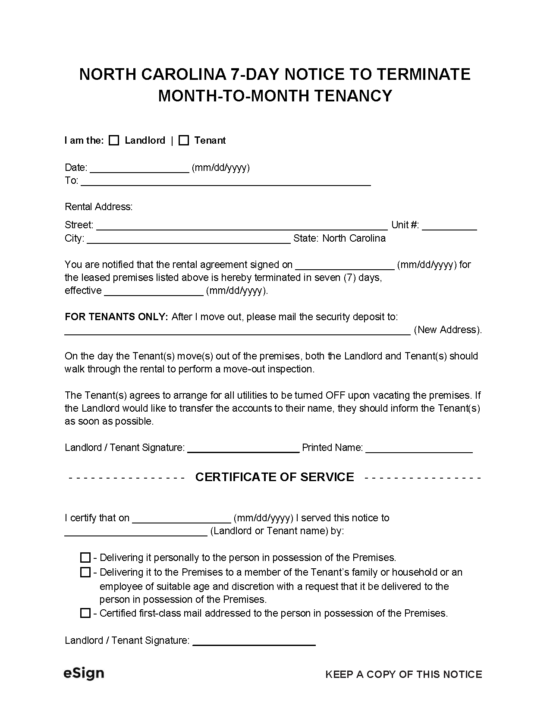

North Carolina eviction notices are used to inform a tenant that their lease will be terminated, the cause of the termination, and the date by which they must move out. If the tenant has not vacated their rental unit by the time that the notice has expired, the landlord may begin legal action to have them evicted. The amount of notice that is mandated by state law depends on the reason for the eviction and, in some cases, may be determined by the conditions of the lease. In the event that a tenant does not comply with an eviction notice, the landlord will need to file a case against them in court to regain possession of their property.

10-Day Notice to Quit for Non-Payment – Demands that a tenant pay unpaid rent within ten (10) days or move out.

7-Day Notice to Terminate Month-to-Month Lease – Can be used by tenants and landlords to terminate a monthly lease agreement.

Notice to Quit for Non-Compliance – Informs the tenant that they have broken the terms of their tenancy and gives them notice in accordance with their lease.
North Carolina’s laws require that landlords give their tenants an eviction notice if they haven’t paid their rent or if the landlord wants to terminate their lease. The notice period that the tenant is given must be in accordance with state law as well as the terms of the lease. For cases of non-payment of rent, the landlord is required to allow the tenant to repay the amount to avoid eviction. If a tenant breaches the terms of their lease, the landlord is not required to give any notice before evicting them. However, if the lease states that a period must be provided for fixable violations, the landlord must follow these provisions as they are written.

When a landlord wishes to terminate their lease agreement with a tenant, they will need to give them the appropriate notice. The eviction forms for non-payment, monthly lease termination, and non-compliance are provided below to be downloaded and completed by the landlord.
The landlord will need to make a copy of the eviction notice for reference in case a lawsuit is required.

When delivering the notice to the tenant, the landlord will either need to do so in person, by certified mail, or by posting it on the property. After delivery has been completed, the “Record of Service” portion must be filled out by the landlord and, if delivered in-person, signed by the tenant.

If the notice expires and the tenant does not move out or fix the situation that led to their eviction, the landlord can begin a lawsuit to have the tenant evicted by court order. Legal action for eviction is started when the landlord completes a Complaint In Summary Ejectment form and files it with the Clerk of Superior Court associated with the county in which the property is located. Summary Ejectment (eviction) cases are usually filed with the Small Claims Court, however, claims of more than $10,000 must be filed with District Court. For lease violation cases that do not require notice, the landlord can file their case immediately.

After a Complaint has been filed, the county sheriff will serve a copy of the document and a Summons form on the tenant. The Summons informs the tenant of the date of hearing and that they may file a written Answer with the Clerk of Superior Court. Furthermore, the Summons mentions that the tenant’s failure to appear in court can result in a judgment against them.

On the date of the hearing, both the landlord and the tenant must be on time for their case to be heard. Either party’s failure to appear at the hearing will usually result in a verdict in the opposing party’s favor. Both parties will need to bring any proof that will support their claims, such as copies of the lease, the expired eviction notice, canceled or bounced checks, witnesses, photographic evidence, and written communications. A verdict in the tenant’s favor means that they will be allowed to continue their tenancy without penalty. If the judge rules in the landlord’s favor, they will issue a Judgment for Possession that orders the tenant to leave.

After a judgment has been made, the tenant will have a ten (10) day period in which they can decide to file an Appeal with the court. If an Appeal is made, the case will need to be heard again and a new judgment made.

If the tenant does not appeal the case or move out within ten (10) days of the judgment, the landlord must request a Writ of Possession from the court to be sent to the county sheriff’s office. Within seven (7) days of receiving the writ, the sheriff will remove the tenant and padlock the property to prevent their re-entry.